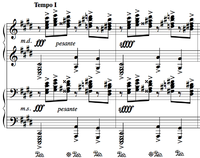
Morceaux de Fantaisie
Encyclopedia
Morceaux de fantaisie Op
. 3, is a set of five piano
solo pieces composed by Sergei Rachmaninoff
in 1892. The title reflects the pieces' imagery rather than their musical form, as none are actual fantasies
.
 Elegie (Элегия, Elegiya) is a musical elegy
Elegie (Элегия, Elegiya) is a musical elegy
at moderato tempo
.

The second piece, Prelude (Прелюдия, Prelyudiya) is undoubtably the most famous of the set.
 Melody (Мелодия, Melodiya) is a short piece played Adagio sostenuto
Melody (Мелодия, Melodiya) is a short piece played Adagio sostenuto
. It was rewritten by Rachmaninoff in 1940, along
with the Serenade.
 The fourth piece, called Polichinelle (Полишинель, Polishinyelʹ) is a unique piece in F sharp minor, played Allegro vivace. It is a character piece, based on the Commedia dell'arte
The fourth piece, called Polichinelle (Полишинель, Polishinyelʹ) is a unique piece in F sharp minor, played Allegro vivace. It is a character piece, based on the Commedia dell'arte
character Pulcinella
(Polichinelle is the French translation of this word) from which Punch (from Punch and Judy
) derives. It is in ternary form
(ABA), beginning and ending with a lightning fast devilish section that gives way to a slower, lyrical melodious passage in the middle.
Opus number
An Opus number , pl. opera and opuses, abbreviated, sing. Op. and pl. Opp. refers to a number generally assigned by composers to an individual composition or set of compositions on publication, to help identify their works...
. 3, is a set of five piano
Piano
The piano is a musical instrument played by means of a keyboard. It is one of the most popular instruments in the world. Widely used in classical and jazz music for solo performances, ensemble use, chamber music and accompaniment, the piano is also very popular as an aid to composing and rehearsal...
solo pieces composed by Sergei Rachmaninoff
Sergei Rachmaninoff
Sergei Vasilievich Rachmaninoff was a Russian composer, pianist, and conductor. Rachmaninoff is widely considered one of the finest pianists of his day and, as a composer, one of the last great representatives of Romanticism in Russian classical music...
in 1892. The title reflects the pieces' imagery rather than their musical form, as none are actual fantasies
Fantasia (music)
The fantasia is a musical composition with its roots in the art of improvisation. Because of this, it seldom approximates the textbook rules of any strict musical form ....
.
Elegie in E-flat minor

Elegy
In literature, an elegy is a mournful, melancholic or plaintive poem, especially a funeral song or a lament for the dead.-History:The Greek term elegeia originally referred to any verse written in elegiac couplets and covering a wide range of subject matter, including epitaphs for tombs...
at moderato tempo
Tempo
In musical terminology, tempo is the speed or pace of a given piece. Tempo is a crucial element of any musical composition, as it can affect the mood and difficulty of a piece.-Measuring tempo:...
.
Prelude in C-sharp minor

The second piece, Prelude (Прелюдия, Prelyudiya) is undoubtably the most famous of the set.
Melody in E major

Sostenuto
In music, sostenuto is a term from Italian which means "sustained." It occasionally implies a slowing of tempo, though more often it refers to a very legato style in which the notes are performed in a sustained manner beyond their normal values....
. It was rewritten by Rachmaninoff in 1940, along
with the Serenade.
Polichinelle

Commedia dell'arte
Commedia dell'arte is a form of theatre characterized by masked "types" which began in Italy in the 16th century, and was responsible for the advent of the actress and improvised performances based on sketches or scenarios. The closest translation of the name is "comedy of craft"; it is shortened...
character Pulcinella
Pulcinella
Pulcinella, ; often called Punch or Punchinello in English, Polichinelle in French, is a classical character that originated in the commedia dell'arte of the 17th century and became a stock character in Neapolitan puppetry....
(Polichinelle is the French translation of this word) from which Punch (from Punch and Judy
Punch and Judy
Punch and Judy is a traditional, popular puppet show featuring the characters of Mr. Punch and his wife, Judy. The performance consists of a sequence of short scenes, each depicting an interaction between two characters, most typically the anarchic Punch and one other character...
) derives. It is in ternary form
Ternary form
Ternary form, sometimes called song form, is a three-part musical form, usually schematicized as A-B-A. The first and third parts are musically identical, or very nearly so, while the second part in some way provides a contrast with them...
(ABA), beginning and ending with a lightning fast devilish section that gives way to a slower, lyrical melodious passage in the middle.
Serenade
This set ends with Serenade (Серенада, Serenada). It was rewritten by Rachmaninoff in 1940, along with the Melodie in E Major.External links
- Sheet music available at the International Music Score Library ProjectInternational Music Score Library ProjectThe International Music Score Library Project , also known as the Petrucci Music Library after publisher Ottaviano Petrucci, is a project for the creation of a virtual library of public domain music scores, based on the wiki principle...
- Piano.ru - Sheet music download

